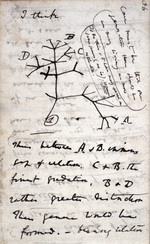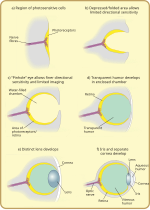Search results
Appearance
There is a page named "Evolution of molluscs" on Wikipedia
- Sex organs of molluscs)characteristic of molluscs is they are unsegmented and bilaterally symmetrical. The following are present in all modern molluscs: The dorsal part of the body...94 KB (9,545 words) - 23:56, 25 June 2024
- Spiralia are a morphologically diverse clade of protostome animals, including within their number the molluscs, annelids, platyhelminths and other taxa....16 KB (1,338 words) - 07:49, 19 May 2024
- dispute as to whether these shell-bearing molluscs form a monophyletic group (conchifera) or whether shell-less molluscs are interleaved into their family tree...41 KB (4,866 words) - 04:59, 21 May 2024
- Evolution is the change in the heritable characteristics of biological populations over successive generations. It occurs when evolutionary processes...238 KB (24,713 words) - 16:27, 22 June 2024
- diversification of butterflies through geologic time Peppered moth evolution – Significance of the peppered moth in evolutionary biology Evolution of molluscs – The...26 KB (4,647 words) - 11:05, 28 February 2024
- of vertebrates, while scallops have up to 100 simple eyes. There are between seven and eleven distinct eye types in molluscs. Molluscs have eyes of all...3 KB (319 words) - 07:43, 18 March 2024
Animal (Metazoan) Evolution)
includes the molluscs, annelids, brachiopods, nemerteans, bryozoa and entoprocts. The molluscs, the second-largest animal phylum by number of described species...
125 KB (11,182 words) - 08:37, 6 June 2024
Many scientists have found the evolution of the eye attractive to study because the eye distinctively exemplifies an analogous organ found in many animal...
45 KB (5,464 words) - 09:12, 21 June 2024
that they have diverged through the process of evolution from a common ancestor. The earliest clear evidence of life comes from biogenic carbon signatures...
235 KB (22,625 words) - 17:30, 22 June 2024
Evolution of marine invertebrates)
the largest shell of any living gastropod Molluscs usually have eyes. Bordering the edge of the mantle of a scallop, a bivalve mollusc, can be over 100...
63 KB (6,561 words) - 10:43, 23 June 2024
"Biochronology of selected mammals, Molluscs and ostracodes from the Middle Pliocene to the Late Pleistocene in Italy. The state of the art" (PDF). Rivista...
177 KB (19,044 words) - 17:38, 2 July 2024
- Spinning Molluscs by Harry Wallis Kew Spinning Molluscs, Kew 3705672Spinning Molluscs — Spinning Molluscs, KewHarry Wallis Kew Zoologist, 1900. Plate
- the ultimate development of mechanical consciousness, in the fact of machines possessing little consciousness now. A mollusc has not much consciousness
- relatives. One main branch includes arthropods, molluscs, annelids, and nematodes. This branch, or a large part of it, usually is called the protostomes. The
)







